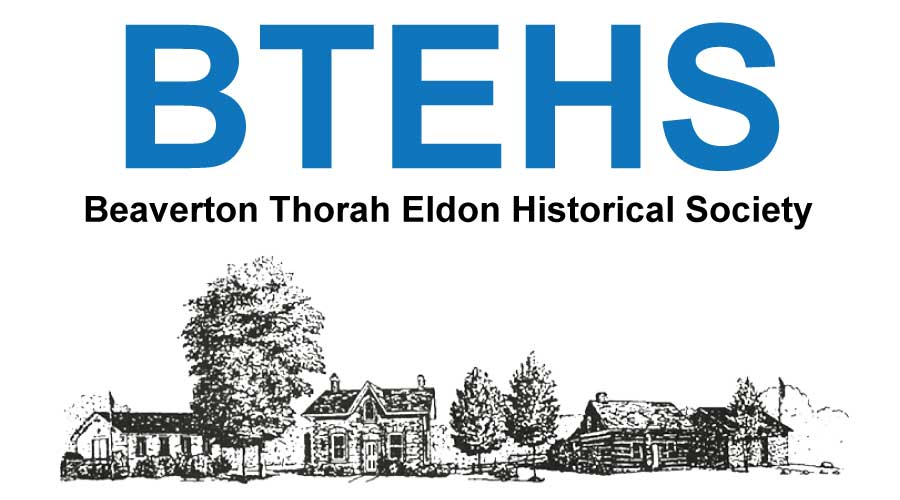History
Beaverton, a Heritage Community, for Sure!
The Beaver River meanders through fertile fields to its mouth at Lake Simcoe where 3000 years ago it was the yearly camping grounds of native people as was Thorah Island 3 miles offshore. Indian artifacts found on these sites date back to that time. Just to the north a plaque on the bridge over the Talbot River reminds us that Champlain passed this way in 1615. Of course, the century-old Trent Severn Waterway is nearby.
In the 1820s settlers, mostly from Scotland, began arriving and a thriving village sprang up. On the site of the first mill, was a four-storey brick mill built in 1863 at the end of the business section. Unfortunately, this mill burned in 1978.
A stone jail was built in the late 1840s in response to a law that every unincorporated village had to have a lockup. Situated along the river, it was moved in 1995 to Centennial Park to preserve it from demolition for a bank parking lot!
The construction of St. Andrew’s, a stone church, was begun in 1840 by the Church of Scotland congregation. Even today, the “Old Stone Church” has regular summer services. Recently, this building was designated a National Historic Site. Thirty some years ago it received provincial designation.
Several other buildings of early times still survive, and of course, many beautiful homes of the late 19th Century line the streets. In 1984, Beaverton’s Centennial year, plaques were placed on more than 40 century-old buildings.
Two early 20th Century public buildings form the centre hub of town. The Beaverton Library, built with Carnegie Foundation funds and in the style of other Carnegie libraries was built in 1912-13. It now has a beautiful addition called the “Peg Baillie Wing”. The Town Hall, built 1910-11, is in use but not for municipal purposes. The “Town Hall Players” a community group of actors perform musicals and plays regularly in its auditorium which was decorated and brought up to standards by volunteers.
Behind the Library and Town Hall is Alexander Muir Park, so named in honour of the composer of “The Maple Leaf Forever” who was principal at Beaverton’s North Street School during 1876-79.
Three of the churches, still being used, date from the 1870s, each unique in its design. St. Paul’s Anglican Church has very beautiful stained-glass windows. Two other places of worship were built in the early 20th Century; one of these, the Beaverton Presbyterian church has been replaced with a new building and the name Beacan Presbyterian Church. Simcoe Street still features many 19th Century buildings housing retail stores. The former Hamilton Hotel, dating from the 1860s is a very imposing structure on the main street.
Celebrating our heritage is the mandate of the Beaverton Thorah Eldon Historical Society. Programs, such as an historical walking tour and a “Then and Now” presentation are offered to the general public and the local school classes. Classes tour the museum buildings, as do many residents and visitors to the town. Two books about the history of the Beaverton area have been written by the Historical Society. The Beaverton Story: Harvest of Dreams focuses on the early residents of the area. Continuing Dreams: The Second Beaverton Story continues the development story of the area but also showcases life in the early part of the 20th century.
Canada Day celebrations certainly have a heritage flavour. During 2009, Beaverton’s 125th year of incorporation was celebrated. Two murals were created that year to highlight this community’s past.
The Beaverton Fair has been held continuously since 1853. Ice fishing is a sport still popular since early times. Cottagers have been coming to the local beaches since the late 1800s.
While ‘Beavertonians’ are proud of the artists, athletes and entrepreneurs who have been on the more recent scene, we acknowledge from our past the accomplishments of William St. Thomas Smith, one of Canada’s finest marine artists, the Checkers Lacrosse team who won the Ontario Intermediate Championship in 1899, and A.P. Cockburn who, as head of the Muskoka Lakes Navigation Company, did much to open up that part of Ontario.
Today’s Beaverton, a caring community, has most of the amenities needed for a modern society. However, there are also many reminders of a very rich history of an eventful past
Author: Helen Alsop
